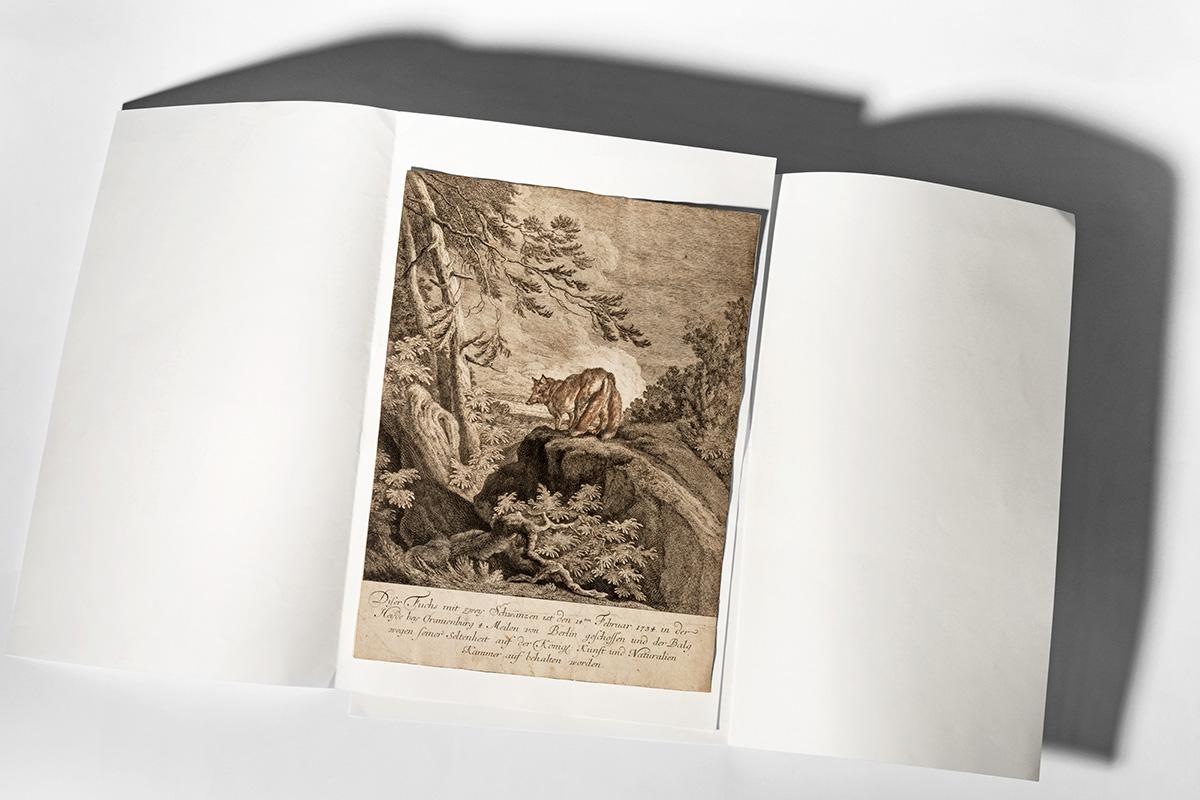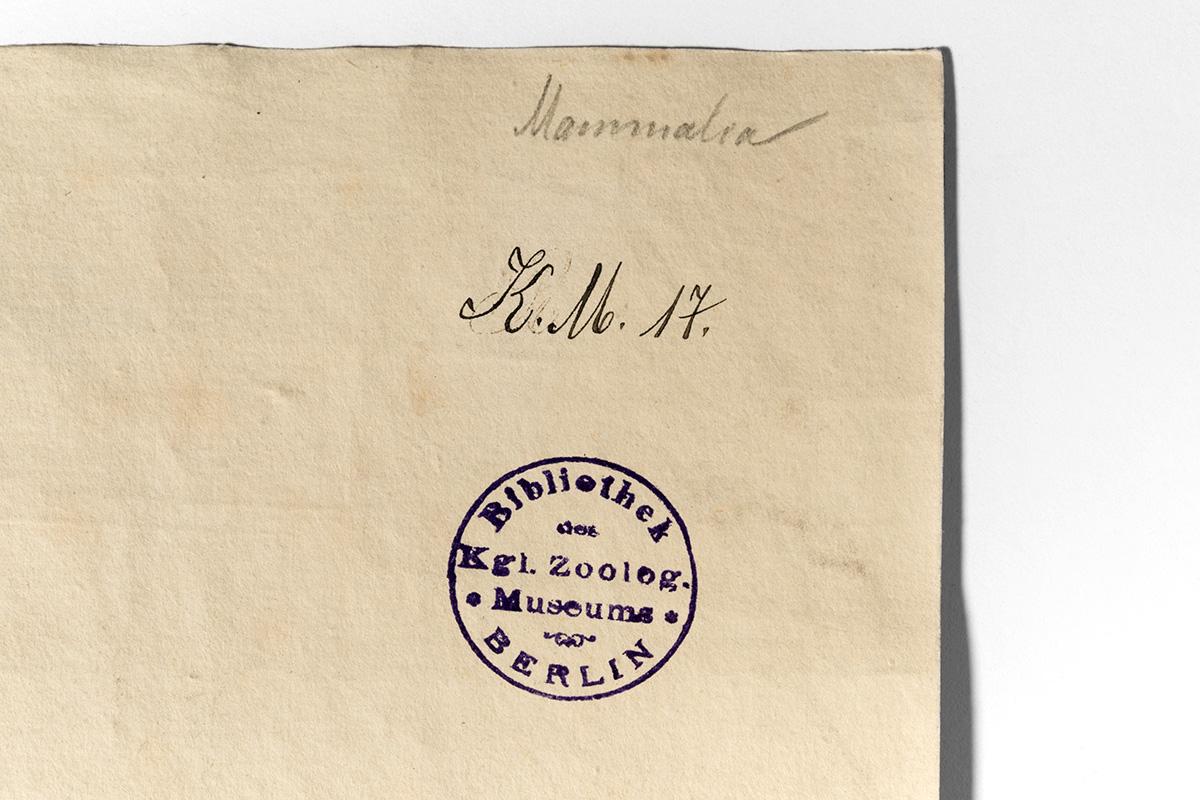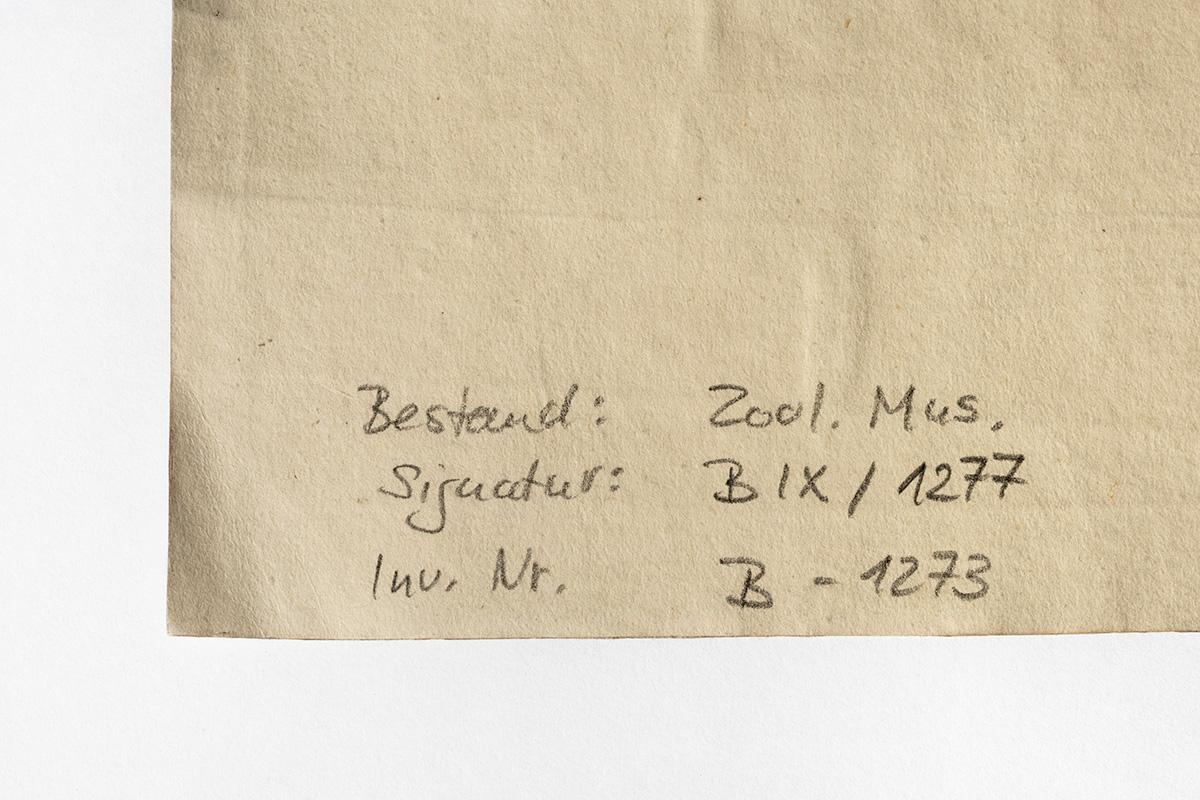Marna Schneider
A small fox glances askance at the viewers from a copperplate engraving, rather impolitely turning its back to them while looking over its shoulder. With the subtle red coloration of its fur, the creature stands out in the middle of a romantic forest atmosphere. Noticeably, the fox carries not one, but two tails. The finely curved caption on the engraving explains: "This fox with two tails was shot on February 14, 1734 in the Heyde near Oranienburg 4 miles from Berlin and the pelt was kept at the Royal Cabinet of Arts and Nature [Königl. Kunst und Naturalien Kammer] because of its rarity."
Today, the copperplate engraving is part of the Historical Image and Document Collections of the Historical Division at the Museum für Naturkunde in Berlin. An inventory book of the image collections reveals that it was transferred there from the museum’s Mammalian Department in 2000. Consisting only of a single sheet with few details and no reference to the artist, the history of this engraving has so far remained a mystery. Only the stamp of the "Bibliothek des Kgl. Zoolog. Museums BERLIN" indicates that the engraving once belonged to the collection of the Royal Zoological Museum, which was founded in 1810 and later became part of the Museum für Naturkunde.
However, the caption provides another clue: the skin of a fox, which was hunted in 1734 and stored in the Kunstkammer in Berlin, is said to have served as a model for the engraving. Indeed, some documents from the Royal Cabinet of Arts and Nature seem to support that thesis. Johann Andreas Silbermann, for example, recollects in his travel guide from 1741: "In an unusual box there was a fox's skin with two tails, which I was given to evaluate to see if it wasn’t sewn on." The document is located at the Saxon State and University Library Dresden (SLUB). In addition, an anonymously published anthology about "Curiosities" from the holdings of the Staatsbibliothek zu Berlin dating to the 1740s or 1750s mentions that Margrave Philip had hunted down the fox. It is striking, however, that more than 20 years separate the death of the margrave – assuming it is Margrave Philipp Wilhelm of Brandenburg-Schwedt (1669–1711) – and the shooting of the fox in the copper engraving. Therefore, the hunter's identity remains uncertain.
Another clue solves the riddle around the artist: a comparison of the engraving with other prints made from the same plate, which can be found in the Staatliche Kunsthalle Karlsruhe, confirms the authorship of the popular animal painter and publisher Johann Elias Ridinger (1698–1767). Ridinger's signature at the lower right margin, as well as the print number in the upper right corner were both cut away in our copy of the engraving. The colouring of this print seems to be unique and must have been applied retrospectively since the Karlsruhe copy is neither cropped nor coloured. In March 2022, a lucky find occurred: 20 of Ridinger's engravings, among others from the album on "besonder[er] Thiere" from 1768, were rediscovered in the Museum für Naturkunde Berlin. Based on the surviving signatures, it can be assumed that the fox engraving originally belonged to the context of a larger collection of prints from the former Zoological Museum.
Ultimately, it is not clear whether the engraving and the fox’s skin were stored together, exhibited, or even handed out to visitors for closer inspection. Today, the engraving can be studied in the Historical Division of the Museum für Naturkunde. The skin, however, remains missing. While there are still feral tracks to be discovered in this story, the copperplate engraving opens up a wondrous path into the courtly world of hunting rituals and the cultural habits of seeing and collecting between the Baroque period and the Enlightenment. By leading us through various archives it thus also contributes to research on the museum’s early history and image collections.
Object Profile
- Title: engraving "Fox with Two Tails" (Fuchs mit zwey Schwänzen)
- Signature: ZM B IX/1277 (inv. no. ZM-B 1273)
- Provenance: library of the Königliches Zoologisches Museum Berlin after 1810, part of the Museum für Naturkunde since 1889, Historical Division since spring 2000 (transferred from the custody of mammals)
- Materials: copperplate engraving on paper, coloured retrospectively
- Author: Johann Elias Ridinger (1698–1767)
- Time of production: ca. 1734
- Place of production: possibly Augsburg
- Keywords: fox, curiosity, Kunstkammer, hunting, copperplate engraving, Johann Elias Ridinger
Bibliography
- Norbert Lieb: "Ridinger, Joh. Elias", in: Allgemeines Lexikon der Bildenden Künstler von der Antike bis zur Gegenwart [Thieme-Becker], ed. by Hans Vollmer, vol. 28, Leipzig 1931 (reprint Zwickau 1978), pp. 308–310.
- Walter Koschatzky: Die Kunst der Graphik. Technik, Geschichte, Meisterwerke, 4 vol., Munich 1999.
- Werner Rösener: Die Geschichte der Jagd. Kultur, Gesellschaft und Jagdwesen im Wandel der Zeit, Düsseldorf/Zurich 2004, esp. pp. 254–304.
- Ellen Spickernagel: "Dem Auge Auf Die Sprünge helfen. Jagdbare Tiere und Jagden bei Johann Elias Ridinger (1698–1767)", in: Topos Tier. Neue Gestaltungen des Tier-Mensch-Verhältnisses, ed. by Annette Bühler-Dietrich and Michael Weingarten, Bielefeld 2016, pp. 103–123.
- Wolf Stubbe: Johann Elias Ridinger, Hamburg/Berlin 1966.
Sources
- Anonymous: no title [castle interiors, Königliche Bibliothek, Zeughaus, contents of the Kunstkammer in 168 numbers], no year, no place [likely 1742–1752], folio 10v [Staatsbibliothek zu Berlin – Stiftung Preußischer Kulturbesitz, signature: SBB PK, Ms. Boruss. quart. 229].
- Jean Henry: Allgemeines Verzeichniss der Königlichen Kunst-, Naturhistorischen und Antiken-Museums, Berlin 1805, p. 12.
- Johann Elias Ridinger: Genaue und richtige Vorstellung der wundersamste[n] Hirsche[n] sowohl als anderer besonder[er] Thiere, welche von großen Herren selbst gejagt, geschoßen, lebendig gefangen, oder gehalten worden, Augsburg 1768, folio 34 [Staatliche Kunsthalle Karlsruhe, inv. no.: PK II 129-10].
- Johann Andreas Silbermann: Anmerckungen derer Auf meiner Sächsischen Reysse gesehenen Merckwürdigkeiten [...], no place, 1741, p. 37, Sächsische Landesbibliothek – Staats- und Universitätsbibliothek Dresden, signature: Mscr.Dresd.App.3091, digital copy SLUB Dresden (last accessed: 23.09.2020).
Image Credits
- Fig. 1: "Fox with Two Tails" (Fuchs mit zwey Schwänzen), copperplate engraving (coloured), Johann Elias Ridinger, ca. 1734, 34 x 25 cm, MfN, HBSB, ZM B IX/1277, © Carola Radke, MfN.
- Fig. 2: Caption and stamp of the Königliches Museum, detail from: "Fox with Two Tails" (Fuchs mit zwey Schwänzen), copperplate engraving (coloured), Johann Elias Ridinger, ca. 1734, 34 x 25 cm, MfN, HBSB, ZM B IX/1277, © Carola Radke, MfN.
- Fig. 3: Annotations of the Historische Arbeitsstelle, detail from: "Fox with Two Tails" (Fuchs mit zwey Schwänzen), copperplate engraving (coloured), Johann Elias Ridinger, ca. 1734, 34 x 25 cm, MfN, HBSB, ZM B IX/1277, © Carola Radke, MfN.


